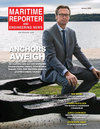
Page 16: of Maritime Reporter Magazine (January 2022)
The Ship Repair & Conversion Edition
Read this page in Pdf, Flash or Html5 edition of January 2022 Maritime Reporter Magazine
The Path to Zero
The Compelling
Decarbonization Solution
By Nick Contopoulos, COO, Anemoi lobal supplier of wind propulsion, Anemoi Ma- ment are delivered to the dockside, ready for installation. The rine, believes Rotor Sails – which are unique, Anemoi team then supervise the full equipment installation. tall cylindrical sails that can be installed on the Each Rotor is installed in a single crane lift and connected to deck of commercial vessels – offer an imme- the foundation on the ship’s deck once the vessel integration diate and compelling solution for shipowners work is complete.
G working to reduce vessel emissions. Prior to this taking place, a feasibility study - which is
Anemoi estimates that a VLCC with six Rotor Sails would unique to each vessel - will have been conducted to determine reduce fuel and emissions by approximately 14.9% (c.1,889 the optimal Rotor Sail positioning. This is to maximize perfor- tons fuel and c.6,058 tons of carbon) per year, based on a Bon- mance within the vessel constraints and the required Deploy- ny-Ningbo round trip. ment System for the vessel.
When considering fuel savings for bulk carriers, Anemoi’s The vessel integration stage is crucial to the process and we research suggests a VLOC ? tted with six Rotor Sails could constantly support clients at every stage, including the design achieve an annual 15.5% fuel and emission reduction based and installation of the structural foundations and the electrical on a Qingdao-Tubarao round trip. This equates to c.1,437 tons cabling from the vessel main switchboard to each Rotor Sail. of fuel and c.4,607 tons of carbon per year. The vessel integration can be completed during the construction
The International Maritime Organization (IMO) wants phase of a newbuild vessel, or during a survey at a shipyard for considerable cuts in ship emissions as part of its 2030 and a retro? t vessel. Once the Rotor Sails are installed and all cables 2050 targets. The goal is to reduce Greenhouse Gas (GHG) are connected, we complete ? nal commissioning of the system emissions from vessels by at least 40% before the end of this prior to handover. This crucial stage ensures safe operation and decade and by at least 50% by 2050 (compared with 2008 compliance with Class requirements through rigorous testing.
baseline ? gures). The long-term target is full decarbonization, although this will likely require a range of solutions. Ease of use and monitoring
The Energy Ef? ciency Design Index (EEDI) is already in The Anemoi Rotor Sail System is comprised of the Rotor place and has been created to ensure newbuild vessels meet req- Sail itself, the Foundation, Deployment System (if required), uisite levels of ef? ciency. The Energy Ef? ciency Existing Ship wind sensors and Electrical, Control, and Automation sys-
Index (EEXI) is due to come into force by January 2023. Carbon tems. The main components of our Rotor Sails are the “Rotor”
Intensity Indicators (CII) are also on the cards. These measures (the cylindrical, rotating part), the support Tower, upper and mean shipowners already have to carefully weigh up the options lower bearings, and the electrical drive system. available to achieve compliance. Debate still surrounds the re- The Rotor is built from advanced lightweight composite alistic timeline, availability and eco nature of alternative fuels. material and the Tower is a steel column structure. We use
As a result, many shipowners are ready to take the plunge and these materials to ensure maximum performance of our Rotor invest in future proof technologies. Installing wind technolo- Sails and to withstand all weather conditions. gies as retro? t or newbuild could be the ideal answer for the The Rotor Sails have a control station located on the bridge. maritime community, particularly as using Rotor Sails would This automatically controls the speed and direction of the Ro- lower the consumption and cost of expensive clean fuels. tor Sails, as well as monitoring the performance and status of the system. Our control system is designed to maximize per-
Simplicity in mind formance and minimize crew input with automated speed and
Installing Anemoi technology can be a straightforward pro- direction setting, equipment monitoring, safety features and cess because wholesale changes to the vessel structure, or dry performance reporting to stakeholders using a ship to shore docking, is not necessary. Rotor Sails and all associated equip- data transmission. 16 Maritime Reporter & Engineering News • January 2022
MR #1 (1-17).indd 16 1/6/2022 9:47:55 AM

 15
15

 17
17
